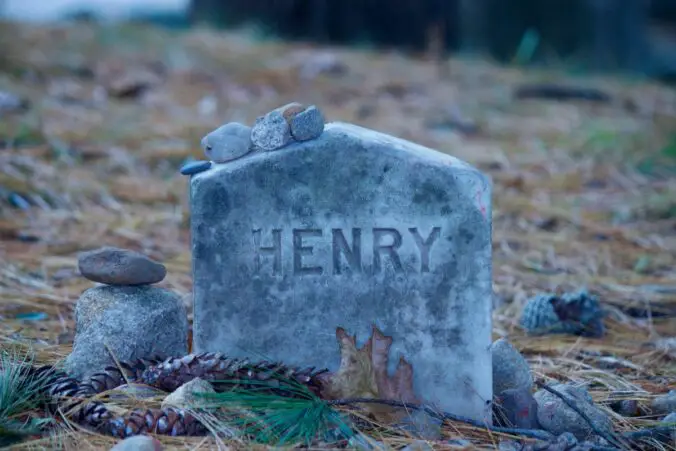Table of Contents
Today, we’re going to answer a question that might have popped into your mind while visiting a cemetery or cleaning a loved one’s grave marker: Can you use WD40 on a headstone?
I know it may seem like an odd question, but bear with me. In this article, we’ll dive deep into the world of WD40, its uses, and its effects on headstone materials as well as whether you should use it or not.
So sit back, grab your favorite beverage, and let’s embark on this intriguing journey together and see what you should do!
To begin, let’s briefly discuss what WD40 is and why it’s such a popular product to use for a variety of things. WD40 is a versatile water-displacing spray that’s been around since the 1950s. It’s well-known for its ability to lubricate, clean, and protect a wide variety of surfaces.
But does that mean it’s suitable for grave markers? Let’s find out!
The Composition of WD40 Spray
Before we jump into whether WD40 is suitable as a headstone cleaner, it’s important that you understand what’s in the can. The exact formula of WD40 is a closely guarded secret (like grandma’s secret sauce), but we do know that it contains a mix of hydrocarbons, aliphatic compounds, and a dash of carbon dioxide as a propellant.
What does all that mean to you? In simpler terms, WD40 is a concoction of various chemicals that give it its unique properties.
Now that we’ve covered the basics of WD40, let’s move on to the main event—headstones and their materials.
Common Headstone Materials
Headstones come in many shapes and sizes, but they’re primarily made from a few common types of stone. These include:
- Granite: A popular choice for its durability and wide range of colors.
- Marble: Known for its classic beauty, but more susceptible to weathering than granite.
- Sandstone: A softer and more porous stone that’s still a common choice for grave markers.
- Slate: A dense, durable material that’s less common due to its higher cost.
Each of these materials has its own unique characteristics, which can affect how they react to different cleaning methods—including the use of WD40.
Effects of WD40 on Headstone Materials
So, what happens when you spray that magic WD40 on a cemetery marker? Well, the answer isn’t straightforward.
Some folks swear by WD40 for cleaning and shining a cemetery marker, while others caution against it. Let’s explore why there’s such a divide.
For starters, WD40 is an oil-based product. This means it can leave a residue on porous materials like sandstone and marble tombstones. This residue can actually attract more dirt and grime, making the marker look worse in the long run.
Additionally, the chemicals in WD40 may react with certain minerals in the headstone, causing discoloration or even weakening the stone over time.
On the other hand, some people have used WD40 on granite headstones without any noticeable issues. The key here is moderation and proper application.
If you’re considering using WD40 on a granite headstone, test it on a small, inconspicuous area first to ensure there are no adverse effects.
Cleaning Gravestones: Traditional Methods
Now that we’ve discussed the potential effects of WD40 on headstones, let’s take a look at some traditional cleaning methods. These tried-and-true techniques can help you keep a headstone looking pristine without the potential risks associated with using WD40.
- Soft brush and water: Gently scrubbing a headstone with a soft brush and water can remove dirt and grime without causing any damage. This homemade solution is cheap and easy to use and you can’t go wrong with just using water.
- Mild soap: If clean water alone isn’t cutting it, a mild soap can be used to help break down tougher stains on markers. Just remember to rinse the headstone thoroughly with water to remove any soap residue.
- Stone-specific cleaning products: You can find a headstone cleaner designed specifically for various types of headstone materials. This solution would be a safer option for headstone markers compared to WD40, as they take into account the unique characteristics of the stone.
- Poultices: For stubborn stains or biological growth, a poultice—a mixture of water, a cleaning agent, and an absorbent material like clay or diatomaceous earth—can be applied to draw out the stain from the stone.
- Professional cleaning: If you’re unsure about the best method for cleaning a headstone or if the task seems too daunting, consider hiring a professional monument conservator who can provide expert guidance and care.
Comparing these traditional methods you can use with WD40, it becomes clear that there are safer and more effective ways to clean and maintain grave markers without risking potential damage.
Potential Damage to Headstone Inscriptions
Inscriptions on grave markers are not only an important way to remember and honor the deceased but also a testament to the craftsmanship of the stone carver. Using WD40 on a headstone can potentially damage these inscriptions, particularly if they’re shallow or already showing signs of wear.
The chemicals in WD40 may cause the inscriptions to become less distinct or even accelerate the erosion of the engraved areas.
In this sense, using WD40 on a headstone may do more harm than good, especially when there are alternative cleaning methods available that pose fewer risks to the integrity of the inscriptions.
Environmental Implications of Using WD40 To Clean A Headstone
Beyond the potential impact on the stone itself, it’s also important to consider the environmental implications of using WD40. When you spray it on a gravestone, the product can seep into the ground and potentially harm the surrounding ecosystem.
This is particularly concerning in older cemeteries where the soil may already be contaminated by pollutants from past practices.
There are eco-friendly alternatives to WD40 that can be used to clean grave markers without posing a threat to the environment. Many of these products are biodegradable and specifically designed to minimize their impact on the earth.
By choosing an environmentally friendly cleaning option, you can help preserve both the stone and the environment for future generations.
Professional Opinions on Using WD40 To Clean A Gravestone
If you’re still on the fence about using WD40 on a gravestone, it’s always a good idea to consult with professionals in the field. Monument conservators and industry experts can provide valuable insights into the best practices for headstone maintenance.
Many professionals discourage the use of WD40 on grave markers due to the potential risks and damage it may cause. They typically recommend more traditional cleaning methods or eco-friendly alternatives that are better suited to the specific type of stone used in the memorial.
By seeking expert advice, you can make an informed decision that will help preserve the memorial for years to come.
Legal and Ethical Considerations When Cleaning Headstones
When it comes to headstone maintenance, it’s essential to be mindful of any legal or ethical considerations. Some cemeteries have specific rules and regulations regarding memorial cleaning and may even prohibit the use of certain products, like WD40.
Additionally, it’s important to respect the wishes of the deceased and their families when considering how to care for a headstone.
Before using any product on a cemetery headstone, take the time to research any applicable regulations and consult with the cemetery staff if necessary. By doing so, you’ll ensure that you’re following the appropriate guidelines and honoring the memory of the deceased in a respectful manner.
Conclusion
To wrap things up, while WD40 may be a miracle worker for many household tasks, using it to get a headstone clean is not recommended due to the potential risks and damage it can cause. Instead, consider using traditional cleaning methods (such as clean water and dish soap) or eco-friendly alternatives specifically designed for headstone maintenance.
By doing so, you’ll preserve the headstone’s beauty, protect the inscriptions, and respect the environment.
Always remember to consult with professionals, adhere to any legal or ethical guidelines, and consider the wishes of the deceased and their families when you got to clean a headstone. In the end, it’s about honoring and preserving the memory of our loved ones, and sometimes, the old-fashioned methods are the best way to achieve that goal.
So the next time you find yourself standing in front of a headstone with a can of WD40 in hand, take a moment to reconsider. The long-term well-being of the headstone and the memory it represents is well worth the extra effort to use a safer and more appropriate cleaning method.
- Can You Pressure Wash A Gravestone? (Is This Tombstone Cleaning Method Safe?) - December 31, 2025
- Can You Use Dawn To Clean A Headstone? (Cleaning Headstones With Soap?) - December 31, 2025
- Can You Clean A Headstone With Vinegar And Water? (Simple Headstones Cleaning Solution) - December 31, 2025



Leave a Reply